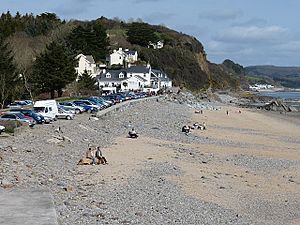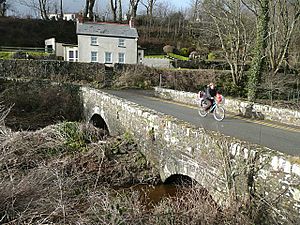Wisemans Bridge facts for kids
Quick facts for kids Wisemans Bridge
|
|
|---|---|
 The seafront at Wisemans Bridge |
|
| OS grid reference | SN144062 |
| Community |
|
| Principal area | |
| Country | Wales |
| Sovereign state | United Kingdom |
| Police | Dyfed-Powys |
| Fire | Mid and West Wales |
| Ambulance | Welsh |
| EU Parliament | Wales |
Wisemans Bridge is a small coastal village in Pembrokeshire, Wales. It sits between the villages of Amroth and Saundersfoot. This charming beachfront spot was once a busy place for mining. Now, it's a popular holiday destination. You can find it along the beautiful Carmarthen Bay.
What's in a Name?
The name Wisemans Bridge has an interesting story. Long ago, this area was called Llanussyllt. After the Normans arrived in Wales, it became known as the Parish of St Issells. This name honored a Welsh saint named Saint Issel.
In 1598, old records from St Issells mentioned a bridge here. Some people think the name came from a smart decision to use this bridge. However, even older records from the 1300s show that a person named Andrew Wiseman owned land nearby. So, the name likely comes from his family. The name Wisemans Bridge was first officially written down between 1898 and 1908.
A Look Back in Time
From the 1300s to the 1800s, the valley behind Wisemans Bridge was a hub for industry. It was part of the Pembrokeshire Coalfield. High-quality coal was mined here. In the 1800s, ships as large as 60 tons carried coal out from Wisemans Bridge.
A special narrow railway line, only 4 feet wide, also moved coal. It took coal to Saundersfoot Harbour through Coppet Hall. This railway line closed for good in 1939. Today, the old railway path and its tunnels are part of the Pembrokeshire Coast Path. This famous walking trail was created in 1970. It's a great way to explore the coast.
In 1943, a very important person visited the area. Winston Churchill, who was the Prime Minister, came to Wisemans Bridge. The Allies were practicing for the D-Day landings here. These were the huge landings in Normandy during World War II.



